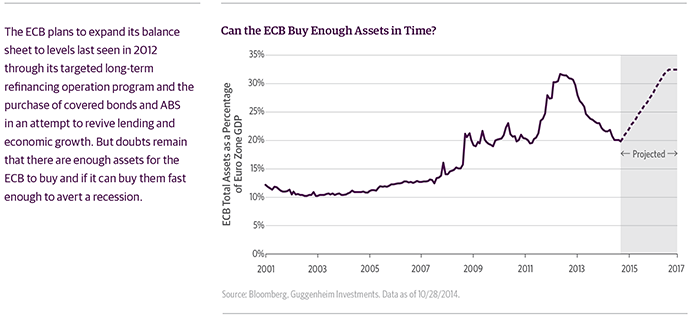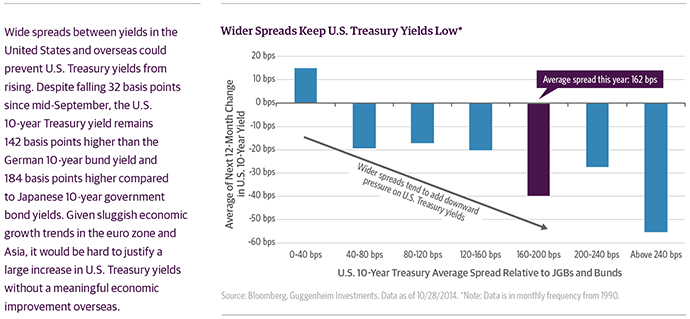October 29 2014
Things in Europe are bad and policymakers appear already to have fallen behind the curve. The reality is the ECB will need to purchase at least another €1.5 trillion in assets, and even that may not be enough to avert a severe slowdown.
by Scott Minerd, Chief Investment Officer, Guggenheim Partners, LLC
A version of this article first appeared in the Financial Times.
In recent conversations—whether with the U.S. Federal Reserve, the European Central Bank, the U.S. Treasury, or the International Monetary Fund—one theme is playing large and loud: things in Europe are bad and policymakers appear already to have fallen behind the curve. Quantitative easing in Europe is coming, but too slowly to avert a severe slowdown and perhaps even a hard landing.
The depreciation of the euro, while welcome, will not be enough to lift the economy out of the doldrums and more must be done both in terms of monetary policy and fiscal reforms. In plain language, France must start taking significant steps to reduce social benefits and improve its fiscal balance (a bitter pill to swallow). Germany must reduce its fiscal surplus, which Chancellor Angela Merkel appears ready to do through increased military and infrastructure spending. Italy must move to reduce its fiscal structural imbalance. Others on the periphery must do their part too by staying the course on austerity and continuing with further structural reform. The European Investment Bank stands ready to support infrastructure investment, but at a scale that currently appears too small to make much of a difference.
In the meantime, the ECB will work as quickly as it can to expand its balance sheet. The problem is simply that there may not be enough assets to buy. Mario Draghi, ECB president, has made it clear that the ECB must increase its balance sheet by at least €1 trillion—a tough mandate as the balance sheet will continue to shrink in the coming year as the earlier longer-term refinancing operation assets roll off. The reality is the ECB will need to purchase at least another €1.5 trillion in assets, and even that may not be enough.

The much heralded asset-backed securities purchase program will only yield about €250 billion to €450 billion in assets over the next two years. More LTRO (or the newer targeted LTRO) will prove a challenge as sovereign bond yields in Europe are so low that a large balance sheet expansion through this means seems impractical. Perhaps there is another €500 billion to €750 billion to do over the next year or two. Outright purchases of sovereign debt would prove politically difficult, as many would interpret such purchases as violating the ECB’s mandate, and the matter would probably end up in the European courts.
Current Tools Will Not Get Job Done
The bottom line is that none of the tools currently on the table will get the job done. There are not enough assets to purchase or finance and the timetable to get anything done is too long. Policymakers do not have the luxury of a year or two to figure this out. The ECB balance sheet shrinks virtually daily and as it shrinks, the monetary base of Europe is contracting and putting downward pressure on prices. Europe is clearly in danger of falling into the liquidity trap, if it is not already there. The likelihood of a “lost decade” like that experienced in Japan is rapidly increasing. The ECB must act and act quickly.
How is this affecting the markets? The recent rally in U.S. fixed income is materially different than when rates last approached 2 percent. Previously, the Federal Reserve was actively managing the yield curve to reduce long-term borrowing costs in order to stimulate the economy. The current rally is caused by a massive deflationary wave unleashed upon the United States by beggar-thy-neighbor policies in Europe and Asia.

Rate Hike in 2016 or Later?
The precipitous decline in energy and commodity prices, and competitive pressures on prices for traded goods, will probably push inflation, as measured by the Fed’s favored personal consumption expenditures index, back down toward 1 percent. This raises the likelihood that any increase in the policy rate by the Fed will be pushed into 2016 or later.
With inflationary expectations falling and the relative attractiveness of U.S. Treasury yields over German bunds and Japanese government bonds, U.S. long-term rates are likely to continue to be well supported with limited room to rise, a dynamic that could push them lower from here.
In the real economy, the decline in energy prices should offset the effect of reduced exports, which is supportive of U.S. growth in the near term. This should help equities recover from the recent storm of volatility as we move deeper into the fourth quarter, which is a time of seasonal strength for the stock market. However, this may prove to be the rally to sell. Results from currency translations for large, multinational companies will likely weigh heavily on S&P 500 earnings in the first half of 2015.
It is too early to be making decisions for next year, but the events overseas provide ominous portents of things to come. If we do get a sign of a bear market in U.S. equities, it could be that the events in Europe presage what lies ahead for the United States. Is it too late to change these shadows of dark foreboding? It is hard to tell but time is not on our side.
INDEX DEFINITIONS
LTRO refers to the ECB’s Long-Term Refinancing Operation program.
RISK CONSIDERATIONS
Fixed income investments are subject to credit, liquidity, interest rate and, depending on the instrument, counter party risk. These risks may be increased to the extent fixed income investments are concentrated in any one issuer, industry, region or country. The market value of fixed income investments generally will fluctuate with, among other things, the financial condition of the obligors on the underlying debt obligations or, with respect to synthetic securities, of the obligors on or issuers of the reference obligations, general economic conditions, the condition of certain financial markets, political events, developments or trends in any particular industry and changes in prevailing interest rates.
Past performance is not indicative of future results. There is neither representation nor warranty as to the current accuracy of, nor liability for, decisions based on such information.
This article is distributed for informational purposes only and should not be considered as investment advice, a recommendation of any particular security, strategy or investment product or as an offer of solicitation with respect to the purchase or sale of any investment. This article should not be considered research nor is the article intended to provide a sufficient basis on which to make an investment decision.
The article contains opinions of the author but not necessarily those of Guggenheim Partners, LLC its subsidiaries or its affiliates. Although the information presented herein has been obtained from and is based upon sources Guggenheim Partners, LLC believes to be reliable, no representation or warranty, express or implied, is made as to the accuracy or completeness of that information.
The author’s opinions are subject to change without notice. Forward looking statements, estimates, and certain information contained herein are based upon proprietary and nonproprietary research and other sources. Information contained herein has been obtained from sources believed to be reliable but is not guaranteed as to accuracy.
This article may be provided to certain investors by FINRA licensed broker-dealers affiliated with Guggenheim Partners. Such broker-dealers may have positions in financial instruments mentioned in the article, may have acquired such positions at prices no longer available, and may make recommendations different from or adverse to the interests of the recipient. The value of any financial instruments or markets mentioned in the article can fall as well as rise. Securities mentioned are for illustrative purposes only and are neither a recommendation nor an endorsement.
Individuals and institutions outside of the United States are subject to securities and tax regulations within their applicable jurisdictions and should consult with their advisors as appropriate.
Guggenheim Investments represents the following affiliated investment management businesses of Guggenheim Partners, LLC: Guggenheim Partners Investment Management, LLC, Security Investors, LLC, Guggenheim Funds Investment Advisors, LLC, Guggenheim Funds Distributors, LLC, Guggenheim Aviation, Guggenheim Real Estate, LLC, Transparent Value Advisors, LLC, GS GAMMA Advisors, LLC, Guggenheim Partners Europe Limited and Guggenheim Partners India Management.
No part of this article may be reproduced in any form, or referred to in any other publication, without express written permission of Guggenheim Partners, LLC. ©2014, Guggenheim Partners, LLC.
Guggenheim Funds Distributors, LLC is an affiliate of Guggenheim Partners, LLC and Guggenheim Investments. For information, call 800.345.7999 or 800.820.0888.
Member FINRA/SIPC GI FIO 1014 #15283
GPIM15283
GIMP-OCT2014-1014 x1015













